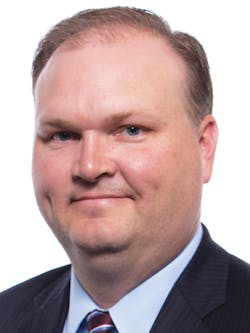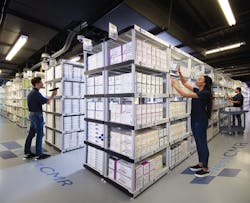Environmental Sustainability: More process than progress?
To some, environmental sustainability represents one of those "damned-if-you-do-and-damned-if-you-don't" idiomatic exercises in that whatever you decide likely will attract criticism, debate and some form of ridicule.
Either it is is too burdensome and costly, it panders to the hippie left and politically correct agendas, it's nothing more than busywork around quotas or it fuels an ego-centric superiority complex.
To others, it's contributing in some way to a higher cause, it respects the finite resources available while keeping future accessibility and availability in mind, it provides "healthier" alternatives to current behaviors and consumption patterns or it represents how to maneuver public opinion and move market share.
All told, environmental sustainability is neither a fad or a trend, but a philosophy with roots and tentacles that have been – and will continue – burrowing deep into administrative, clinical, financial and operational planning. The questions linger about how deeply, how pervasively and how quickly?
Making the case
Among healthcare organizations, the outlook for environmental sustainability remains buoyant and sanguine, compared to the divergent and diverse points of view held by cynics, skeptics and procrastinators awaiting executive orders, financial studies or regulatory requirements regarding more efficient use of products and services, including energy.
In the past, proponents either emphasized the effects on individual patient care or spread the evangelism out to entire communities and even the world. These days, however, they're blurring the lines between the individual and the communal – locally, regionally and globally.
"The idea of 'doing no harm' has now reached beyond individual patient care to planetary care," Chase told Healthcare Purchasing News. "Of the greenhouse gas emissions contributed by U.S. hospitals, 14 percent comes from purchased goods and services. Those goods result in 4.67 million tons of waste each year."
Chase contends that environmental sustainability involves the individual but extends well beyond it to achieve any meaningful degree of progress.
"As an industry, it will take a unified commitment to move healthcare forward," Chase indicated. "One sustainability initiative at one system will not significantly move the needle, but a change in behavior across all hospitals can make an impact. During the Global Climate Action Summit held in San Francisco last year, I heard Bernard Tyson with Kaiser Permanente state that sustainability programs at Kaiser will not be enough to help the industry, but all industry stakeholders were needed. That message was repeated by all respective industry leaders."
"Many people define environmentally preferred sourcing (EPS) as purchasing products that are better for the environment, but this is only one factor," Indiveri noted. "At its core, it's about patient safety and improving human and environmental health.
"There are different subsets of patients, and some have more vulnerability to toxic chemicals than others, such as infants and patients with compromised immune systems," Indiveri continued. "EPS is about removing toxic chemicals from the healthcare supply chain to ensure patient wellbeing, but it's also about the safety of clinicians who may be exposed to harmful chemicals on a day-to-day basis for long periods of time. Environmentally preferred sourcing helps ensure that they are not inadvertently harmed while supporting the healing process for patients."
Economic and fiscal restraints continue to cloud progress and shroud achievement, several executives lament.
"Healthcare is a capital-intensive business, and the opportunity to reduce an organization's energy expenses by 10, 20, or even 30 percent is very appealing," he said. "Many successful programs have leveraged these early financial wins to build leadership support and fund a broader program."
Even how facilities handle excess and open-but-unused inventory can leave a stain on sustainability.
For more than two decades, WestCMR has helped supply chain professionals buy, sell and liquidate in-date surgical supplies throughout the U.S. and in more than 60 countries.
"Hospitals and surgery centers need outlets for distressed inventory from switching OEMs, budget cuts, surgeon preference changes and returns," Greene continued. WestCMR purchases surplus inventory and redistributes products to facilities at a discount in the quantity needed.
"By collaborating with our supply chain customers, WestCMR is committed to becoming a Zero Landfill Company by 2020'" said Elvis Mrsic, Director, Operations, WestCMR.
From WestCMR's viewpoint, rather than discarding in-date supplies left to expire, healthcare facilities can participate in both economic and environmental sustainability concurrently as "cost savings are also passed on when neighboring facilities utilize each other's excess inventory during this process," said Rich Blanchard, Manager, Strategic Accounts, WestCMR.
"The medical field has always been one of the tougher industries to incorporate the use of recycled plastics due to regulatory hurdles, especially for products that are intended to have human skin contact," he said. "As biocompatibility technologies have evolved and medical device companies have adopted sustainability goals, the trend is slowly moving in a favorable direction."
Still, von Het Hof recognizes the simmering demand underlying this issue.
"There is the very real urgency of reducing waste, litter and the environmental impact of plastic, and the global need to set ambitious milestones to meet these goals and propel the circular economy forward," he said. "In addition to this environmental reality, there is a growing demand from consumers who want to buy more sustainable products from companies that are operating with sustainability in mind. Our role as a materials provider allows us to innovate to meet the unique needs of our clients to create more sustainable products, and help them to be a more sustainable company."
Not all or nothing
Some question the breadth and depth of environmental sustainability efforts and accomplishments. How far do you go? Completely? How realistic is that based on products available and prevailing attitudes? Partially? Where do you draw the line in terms of percentages?
"It is not realistic to be completely environmentally sustainable at this time," said Medxcel's Scher. "Most well-intentioned organizations are focused on minimizing their impact on the environment. Every product requires resources for manufacture, distribution and disposal. An emerging topic is to take ownership of the full product lifecycle, including disposition after use. In order to be completely sustainable, more organizations are going to have to take steps to understand true costs and to involve manufacturers and suppliers in product stewardship – sustainable materials, source reduction, packaging, shipping and disposal. That is a very important, but complex, step in the journey toward true sustainability."
Vizient's Indiveri agrees that full-on environmental sustainability isn't possible.
"In many instances, a safe, sustainable alternative product option has not yet been created," she indicated. "Without clearly defined industry standards and oversight, sustainability is more of a journey than an end goal. The Vizient approach toward adding safer products to our portfolio that help members on this journey is aggressive but realistic.
"Some organizations evaluate and deem products as environmentally sustainable by looking for just one environmentally preferred characteristic, such as if the product is recyclable. Vizient evaluates every product using 23 standardized, environmentally preferred product attributes that include a list of 11 chemicals of concern as well as attributes that minimize waste in various different ways. The attributes we apply take into account products that have a reduced impact on human health and the environment," she added.
Much depends on the healthcare organization's goals, size and overall commitment, according to Medline's Olivier.
"Implementing best practices can be a huge culture change for organizations, so I recommend thinking about it in stages," she advised. "Before even starting to create a plan though, think about your biggest areas of concern. This shouldn't be an all-or-nothing approach. Rather, it is an opportunity to start where you think you can have the biggest enviromental impact at your organization."
NewGen Surgical's Chase concurs.
"In healthcare there is plenty of room to go as environmentally sustainable as you can with various products and services," he noted. "There are other materials or processes that can be adopted without impact on patient care and safety. Part of our Smart Sustainable Design approach is to go as green as possible with products that deliver equal or better clinical performance. However, in healthcare, in order to mitigate infections and other risks, or for materials required for procedures, going completely environmentally sustainable, would be a challenge today. But big impacts can be had with simple product conversions and should be considered sooner than later."
What makes total environmental sustainability unrealistic is the availability of options in the marketplace, according to GX's Starr.
"Unfortunately, in today's market, there aren't sufficient alternative products available to convert all of the items that are not 'green' to better alternatives," she said. "The challenges to moving the market come down to product demand. If you listen to the conversations around sustainability in supply chain, it would appear there is the desire to use green products. However, in practice, demand is low.
Starr attributes the complications to three mitigating factors.
- Converting to more sustainable products can often be in conflict with other supply chain strategies including compliance to national groups, she observed.
- Identifying sustainable products is complicated, and most organizations don't have expertise in all supply categories to first identify what should be included/excluded from specific products, and then apply that "standard" to each SKU, which GX actually does, she noted.
- Identifying more sustainable products that also function at an acceptable level for the use in which they are intended can take time and effort. This work is often pushed to a lower priority and often isn't tackled, she said.
Realistically, "there will always be some level of waste, due to advancements in technology, along with unforeseen circumstances that lead to shifts in the normal course of business," said WestCMR's Blanchard.
But that shouldn't encourage complacency and discourage healthcare organizations from doing nothing, particularly in the area of excess products, according to WestCMR's Greene.
"Hospitals and surgery centers need outlets for distressed inventory from conversions, contract changes and surgeon preference changes," she noted. "However, facilities should at least attempt to put some level of effort into sustainability."
"It's impossible to avoid the realities of apparel manufacturing and how it impacts the environment," she said. "That is why Barco has been integrating recycled plastic bottles into its scrubs since 2006. Becoming more sustainable is a key goal for Barco. However, it's somewhat dependent on and driven by the healthcare consumer's mindset, demand and willingness to spend a little more for sustainable products, and in our case, choice to purchase sustainable scrubs. As we watch the overall apparel industry purchasing behavior, we are seeing a shift in that direction especially with the Gen Z target consumer."
Show me a number
If complete environmental sustainability is unrealistic if not unreachable, then what might be the "ideal" percentage or ratio of environmentally sustainable products and services to traditional counterparts? Much depends on how you define "ideal." Does that represent what's achievable or merely the goal?
Executives offer mixed reviews.
"There is no perfect number for everyone," GX's Starr surmised. "Geography can provide benefits or pose challenges with sustainable products. Are composting facilities available is an example. In addition, the service lines at health systems change product mix and opportunities. So really the key is to set incremental goals, gain leadership support of the work and communicate successes and plans widely within the organization. This work can also provide a community engagement opportunity that should be employed to optimize efforts."
As one example of measured evidence, NewGen Surgical's Chase cites a United Nations document, "Environmental Impacts of the U.S. Healthcare System and Effects on Public Health. PLOS ONE 11(6): e0157014, United Nations Office for Project Services High Impact Procurement Report and Healthcare Climate Footprint Report," as a notable benchmark.
"A committee, perhaps nominated representatives of relevant healthcare associations and government, could review the activities, what sustainability efforts could provide the largest benefit for the associated investments, and recommend policies," he added.
Medxcel's Scher bridles his optimism but leaves the door open for progressive momentum.
"The ideal percentage of environmentally sustainable products and services is 100, but we've already discussed that isn't easily achieved," he told HPN. "A practical target will vary by organization based on their definition of environmentally sustainable, plus factors like industry focus, financial situation, region and many others that drive purchase decisions. I agree that measuring compliance is important to drive improvement, but starting with a few high-value categories and building a comprehensive approach over time is a great strategy."
Michaela Griggs, Executive Vice President, Healthcare/Identity Divisions, Barco Uniforms, links her company's passion for and inclusion of environmentally sustainable materials in more than 20 percent of its brands to consumer direction.
"The consumer's mindset and commitment to sustainability is what determines the demand and commitment to sustainable products," she noted, "In our case, [their] choice to purchase sustainable scrubs."
Trinseo's von Het Hof calls it an "evolving process driven by society, industry, brand owners, politics and others" but that "in the end, everything we do should be sustainable."
See also: Embarking on environmental sustainability
Reference:
1. https://www.wastedive.com/news/study-us-operating-rooms-produce-more-than-2000-tons-of-waste-daily/425955/
About the Author
Rick Dana Barlow
Senior Editor
Rick Dana Barlow is Senior Editor for Healthcare Purchasing News, an Endeavor Business Media publication. He can be reached at [email protected].














